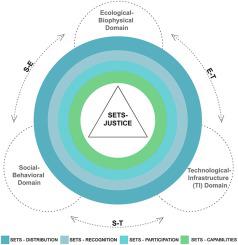Landscape and Urban Planning ( IF 7.9 ) Pub Date : 2021-08-25 , DOI: 10.1016/j.landurbplan.2021.104228 Melissa Pineda-Pinto 1 , Pablo Herreros-Cantis 2 , Timon McPhearson 3, 4, 5 , Niki Frantzeskaki 1 , Jing Wang 6, 7, 8 , Weiqi Zhou 6, 7, 8

|
Examining justice in cities requires using analytical approaches that can unpack their complex nature and reveal the many interacting dimensions that affect justice patterns and processes. Although justice in cities has been examined extensively, it has primarily focused on social and environmental dimensions. However, justice is multi-dimensional, influenced and affected by multiple actors, dynamics, and processes. In this paper we propose the use of ecological justice, as justice of, to, and for nature as a critical lens for portraying a more integral understanding of urban injustices. This lens extends the notion of justice to nature through four dimensions: distribution of harmful impacts, recognition of nature, participation of nature, and the capabilities of social-ecological systems. Through a relational lens we develop a methodology that uses the social-ecological-technological system (SETS) conceptual framework to unpack how the dimensions and interactions affect ecological justice across urban landscapes. This methodology is operationalized into measurable variables and applied through a case study in New York City. A spatial analysis of indicators that act as SETS-Justice proxies at a Community District level, reveal high spatial variability of ecological justice hotspots when looking at each dimension independently. Identifying ecological justice hotspots can provide critical information for improving ecological justice through multiple means. For example, hotspots lacking in social-ecological recognition and participation of nature can inform context-specific solutions such as policies and projects that target community engagement, capacity building, and improve ecological knowledge. Additionally, a composite analysis of SETS-Justice through the aggregation of all indicators, reveals justice hotspots different to those commonly mapped in other justice-focused studies. This approach highlights the need to jointly address issues of environmental and ecological justice.
中文翻译:

在美国纽约市的社会-生态-技术系统中考察生态正义
检查城市中的正义需要使用分析方法来解开其复杂的性质并揭示影响正义模式和过程的许多相互作用的维度。尽管城市中的正义得到了广泛的研究,但它主要集中在社会和环境方面。然而,正义是多维的,受多个参与者、动态和过程的影响和影响。在本文中,我们建议使用生态正义,作为正义的、为的和为了自然是描绘对城市不公正的更全面理解的关键镜头。这个视角通过四个维度将正义的概念扩展到自然:有害影响的分布、对自然的认识、自然的参与以及社会生态系统的能力。通过关系视角,我们开发了一种方法,该方法使用社会-生态-技术系统 (SETS) 概念框架来解开维度和相互作用如何影响整个城市景观的生态正义。这种方法被运用到可衡量的变量中,并通过纽约市的案例研究加以应用。在社区级别作为 SETS-Justice 代理的指标的空间分析,在独立查看每个维度时揭示了生态正义热点的高空间变异性。识别生态正义热点可以通过多种方式为改善生态正义提供关键信息。例如,缺乏社会生态认识和自然参与的热点可以为特定于环境的解决方案提供信息,例如针对社区参与、能力建设和提高生态知识的政策和项目。此外,通过汇总所有指标对 SETS-Justice 进行的综合分析揭示了与其他以司法为重点的研究中通常绘制的不同的司法热点。这种方法突出了共同解决环境和生态正义问题的必要性。缺乏社会生态认识和自然参与的热点可以为特定于环境的解决方案提供信息,例如针对社区参与、能力建设和提高生态知识的政策和项目。此外,通过汇总所有指标对 SETS-Justice 进行的综合分析揭示了与其他以司法为重点的研究中通常绘制的不同的司法热点。这种方法突出了共同解决环境和生态正义问题的必要性。缺乏社会生态认识和自然参与的热点可以为特定于环境的解决方案提供信息,例如针对社区参与、能力建设和提高生态知识的政策和项目。此外,通过汇总所有指标对 SETS-Justice 进行的综合分析揭示了与其他以司法为重点的研究中通常绘制的不同的司法热点。这种方法突出了共同解决环境和生态正义问题的必要性。揭示了与其他以司法为重点的研究中常见的司法热点不同的司法热点。这种方法强调了共同解决环境和生态正义问题的必要性。揭示了与其他以司法为重点的研究中常见的司法热点不同的司法热点。这种方法突出了共同解决环境和生态正义问题的必要性。











































 京公网安备 11010802027423号
京公网安备 11010802027423号